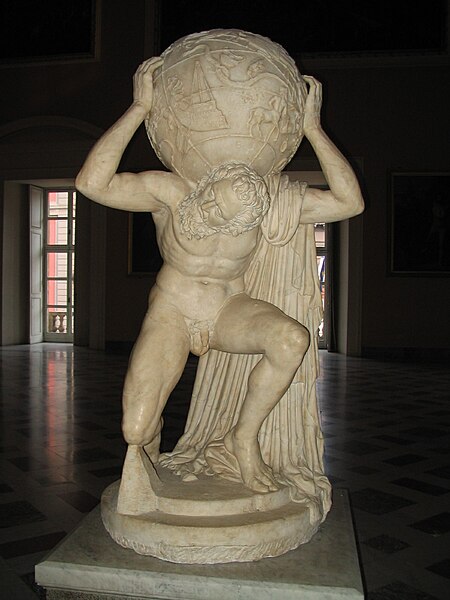Farnese Atlas

The Farnese Atlas is a 2nd-century AD Roman marble sculpture of Atlas holding up a celestial globe. Probably a copy of an earlier work of the Hellenistic period, it is the oldest extant statue of Atlas, a Titan of Greek mythology who is represented in earlier Greek vase painting, and the oldest known representation of the celestial spheres and the classical constellations. The sculpture is at the National Archaeological Museum of Naples, in Italy. The statue is dated around AD 150, during the Roman Empire and after the composition of the Almagest by Claudius Ptolemy, but the celestial globe has long been presumed to represent constellations mapped in earlier Hellenistic astrology, particularly in the work of Hipparchus in the 2nd century BC.Atlas labors under the weight because he had been sentenced by Zeus to hold up the sky. The sphere shows a depiction of the night sky as seen from outside the outermost celestial sphere, with low reliefs depicting 41 (some sources say 42) of the 48 classical Greek constellations distinguished by Ptolemy, including Aries the ram, Cygnus the swan and Hercules the hero. The sculpture stands seven feet (2.1 meters) tall, and the sphere is 65 centimeters (26 inches) in diameter. The name Farnese Atlas reflects its acquisition by Cardinal Alessandro Farnese in 1562, and its subsequent exhibition in the Villa Farnese.
Excerpt from the Wikipedia article Farnese Atlas (License: CC BY-SA 3.0, Authors, Images).Farnese Atlas
Piazza Museo Nazionale, Naples Municipalità 3
Geographical coordinates (GPS) Address Phone number Website Nearby Places Show on map
Geographical coordinates (GPS)
| Latitude | Longitude |
|---|---|
| N 40.8534 ° | E 14.2505 ° |
Address
Museo archeologico nazionale di Napoli
Piazza Museo Nazionale 19
80135 Naples, Municipalità 3
Campania, Italy
Open on Google Maps











